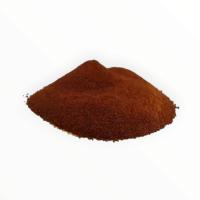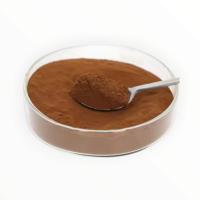| Sign In | Join Free | My himfr.com |
|
| Sign In | Join Free | My himfr.com |
|
| Ask Lasest Price | |
| Brand Name : | Jingshida |
| Certification : | None |
| Model Number : | None |
| Price : | Negotiable |
| Delivery Time : | within one week |
| Payment Terms : | T/T |
| Supply Ability : | 100,000 tons |
Potassium humate granules are made of molasses yeast liquid using fluidized bed technology and are widely used in various flushing, drip irrigation, and biological fertilizers.

1. Core mechanism of action
▪Soil structure improvement: Fulvic acid combines with soil
particles through functional groups such as carboxyl and phenolic
hydroxyl groups to promote the formation of aggregate structure,
increase porosity by 15%-30%, and improve water and fertilizer
retention capacity (permeability increased by 40% after
saline-alkali land improvement).
▪Nutrient activation and slow release: Chelating fixed phosphorus
and potassium, the release efficiency is increased by 50%;
synergistic with chemical fertilizers can reduce nitrogen
volatilization by 30%-50% (such as urea + potassium humate ammonia
volatilization reduced by 45%).
▪Adversity regulation: Induce crops to synthesize proline, SOD
enzyme and other stress-resistant substances, increase leaf water
holding rate by 20% under drought conditions, and enhance root
activity by 35% under salt stress.
2. Practical application plan
Improving the quality of economic crops
▪Fruit trees: Apply mineral potassium humate (5kg/mu) during the
fruit expansion period, the sugar content of apples will increase
by 2-3 degrees, and the cracking rate will decrease by 50%.
▪Vegetables: Spray 800 times of solution on the leaves, the vitamin
C content of cucumbers will increase by 18%, and the nitrate
content will decrease by 25%.
Efficiency enhancement of field crops
▪Rice: Apply biochemical potassium humate (10kg/mu) as a base
during the tillering period, the number of effective tillers will
increase by 15%, and the thousand-grain weight will increase by 5%.
▪Wheat: Combined with topdressing during the jointing period, the
number of grains per ear will increase by 8-10, and the incidence
of fusarium wilt will decrease by 30%.
3.Precautions
▪Avoid mixing with strong alkaline substances: such as Bordeaux
mixture and lime sulfur mixture, with an interval of ≥7 days.
▪Control of dosage in saline-alkali land: Mineral source type
≤500g/mu, to prevent excessive complexation and release of salt.
1. Core mechanism of action
Water quality optimization: adsorption of ammonia nitrogen and
nitrite, with a binding rate of 60%-70%; stable pH at 7.5-8.5,
reducing the risk of ammonia poisoning in fish.
Algae phase balance: provide carbon source (C/N ratio 10:1),
promote the proportion of diatoms from 30% to 60%, and reduce the
proportion of cyanobacteria to below 10%.
Bottom improvement: decompose sediment hydrogen sulfide (removal
rate ≥50%), increase benthic beneficial bacteria (the number of
Bacillus increased by 3-5 times).
2. Practical application plan
Shrimp farming
▪Pre-stocking treatment: spread granules at 2kg/mu to promote
sediment mineralization and increase the survival rate of young
shrimp by 20%.
▪Mid- and late-stage management: spray 0.5ppm mineral potassium
humate every 10 days, and the incidence of white stool disease will
decrease by 40%.
Fish farming
▪Low-temperature fertilizer water: Use 1kg/mu of mineral-source
fertilizer below 5℃, and the algae density will reach 200,000
cells/mL within 7 days, and the dissolved oxygen will increase by
1.5mg/L.
▪Emergency treatment: When ammonia nitrogen exceeds the standard,
1ppm potassium humate + aerator, ammonia nitrogen will drop by
0.3mg/L within 4 hours.
3.Precautions
▪Reduction in high temperature season: Reduce the dosage by 30% to
avoid increased oxygen consumption at night.
▪Cooperate with disinfectants: Apply potassium humate 48 hours
after using chlorine dioxide to avoid oxidation failure.
1.Core mechanism of action
▪Nutrient enhancement: Provide organic potassium (absorption rate
is 40% higher than potassium chloride), promote milk production of
dairy cows (average daily +1.5kg), and increase milk protein rate
by 0.2%.
▪Intestinal health: Adjust rumen pH to 6.2-6.5, increase
cellulose-decomposing bacteria by 50%, and reduce feed-to-meat
ratio by 0.2 (beef cattle test data).
▪ Manure treatment: adsorption of ammonia (reducing odor by 60%),
shortening composting time by 7-10 days, and inactivation rate of
fecal coliform bacteria>90%.
2. Practical application scheme
Ruminants
▪ Dairy cows: Adding 0.5% potassium fulvic acid from mineral
sources to the diet can reduce milk production fluctuations by 70%
during the heat stress season and reduce hoof disease rate by 25%.
▪ Sheep: Adding 10g per head per day during the fattening period
can increase daily weight gain by 8% and significantly improve wool
gloss.
▪ Laying hens: Adding 0.1% potassium fulvic acid solution to
drinking water can increase eggshell thickness by 0.03mm and reduce
egg breakage rate by 2%.
▪ Broilers: Used in combination with probiotics, the weight of
broilers at 42 days of age increases by 5%, and the feed-to-meat
ratio drops to 1.55:1.

|




